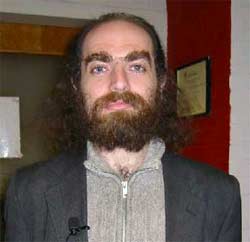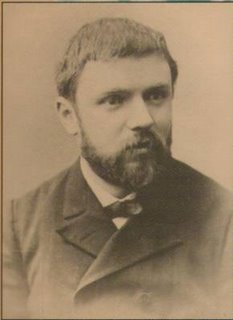Excêntricos (I)
 Eu ainda preciso achar aquela referência de um historiador da matemática, que o Daniel Ferrante achou horrível, dizendo que os grandes avanços nessa área se devem a apenas meia dúzia de pessoas a cada século. Acho que isso talvez seja plausível, não sendo louvação do mito do gênio histórico mas sim apenas mais um caso de eventos extremos em leis de potência aplicadas a impactos científicos (ou seja, as revoluções Kuhnianas justificadas pela física estatística).
Eu ainda preciso achar aquela referência de um historiador da matemática, que o Daniel Ferrante achou horrível, dizendo que os grandes avanços nessa área se devem a apenas meia dúzia de pessoas a cada século. Acho que isso talvez seja plausível, não sendo louvação do mito do gênio histórico mas sim apenas mais um caso de eventos extremos em leis de potência aplicadas a impactos científicos (ou seja, as revoluções Kuhnianas justificadas pela física estatística).
Gênio excêntrico fez descoberta do ano
RICARDO BONALUME NETO
da Folha de S.Paulo
A resposta para um enigma secular da matemática, a conjectura de Poincaré, foi considerada pela revista científica americana "Science" o mais importante avanço científico de 2006.
O feito foi obra de um excêntrico e recluso matemático russo, Grigori Perelman, e trouxe na esteira polêmicas e conflitos de egos entre outros pesquisadores. Perelman ganhou a Medalha Fields, prêmio considerado o "Nobel" da matemática, mas recusou.
Mas não foi esse o único fato que demonstrou mais uma vez como a ciência é uma atividade humana, sujeita aos mesmos caprichos de outras, como o esporte, a política ou a arte.
(...)
Geometria de borracha
A conjectura foi proposta pelo matemático francês Jules Henri Poincaré em 1904. Durante sete anos, Perelman trabalhou na sua demonstração, que expôs em três artigos em 2002. "Em 2006, quase quatro anos depois", diz a "Science", "pesquisadores chegaram a um consenso de que Perelman tinha resolvido um dos mais veneráveis problemas da área".
Poincaré é o fundador da topologia, disciplina que estuda as propriedades mais fundamentais das formas, aquelas que não são perdidas com deformações. É uma espécie de "geometria de borracha", na qual um objeto pode ser esticada e comprimido, mas não rasgado ou remendado.
A conjectura, grosso modo, afirma que dadas três dimensões, é impossível transformar uma forma com um furo no meio, como uma rosquinha, numa esfera, sem apelar para cortes e remendas. Mas formas sem furos têm como ser deformadas até virarem esferas --considerando uma quarta dimensão espacial.
Um grande passo na resolução foi dado em 1982 pelo matemático americano Richard Hamilton, que criou uma técnica, o "fluxo de Ricci", que trata matematicamente as formas com uma espécie de ferro de passar, "alisando-as". Mas mesmo assim sobravam "caroços" no fluxo. Só Perelman conseguiu eliminar o problema.
Outros autores, nos EUA e na China, confirmaram o trabalho de Perelman, mas começaram a brigar entre si por causa de supostos méritos, plágios, e declarações polêmicas. O próprio Perelman ficou indignado com os "padrões éticos" dos colegas.
The Fields Medal and Millennium Prize
In May 2006, a committee of nine mathematicians voted to award Perelman a Fields Medal for his work on the Poincaré conjecture.[2] The Fields Medal is the highest award in mathematics; two to four medals are awarded every four years.
Sir John Ball, president of the International Mathematical Union, approached Perelman in St. Petersburg in June 2006 to persuade him to accept the prize. After 10 hours of persuading over two days, he gave up. Two weeks later, Perelman summed up the conversation as: "He proposed to me three alternatives: accept and come; accept and don’t come, and we will send you the medal later; third, I don’t accept the prize. From the very beginning, I told him I have chosen the third one." He went on to say that the prize "was completely irrelevant for me. Everybody understood that if the proof is correct then no other recognition is needed."[2]
On August 22, 2006, Perelman was publicly offered the medal at the International Congress of Mathematicians in Madrid, "for his contributions to geometry and his revolutionary insights into the analytical and geometric structure of the Ricci flow".[11] He did not attend the ceremony, and declined to accept the medal.[12][13]
He had previously turned down a prestigious prize from the European Mathematical Society,[13] allegedly saying that he felt the prize committee was unqualified to assess his work, even positively.[10]
Perelman may also be due to receive a share of a Millennium Prize (possibly together with Hamilton). While he has not pursued formal publication in a peer-reviewed mathematics journal of his proof, as the rules for this prize require, many mathematicians feel that the scrutiny to which his eprints outlining his alleged proof have been subjected exceeds the "proof-checking" implicit in a normal peer review. The Clay Mathematics Institute has explicitly stated that the governing board which awards the prizes may change the formal requirements, in which case Perelman would become eligible to receive a share of the prize. [citation needed] Perelman has stated that "I’m not going to decide whether to accept the prize until it is offered."[2]
Withdrawal from mathematics
As of the spring of 2003 Perelman no longer works in the Steklov Institute.[3] His friends are said to have stated that he currently finds mathematics a painful topic to discuss; some even say that he has abandoned mathematics entirely.[14] According to a recent interview, Perelman is currently jobless, living with his mother in St Petersburg.[3]
Although Perelman says in the New Yorker article that he is disappointed with the ethical standards of the field of mathematics, the article implies that Perelman refers particularly to Yau's efforts to downplay his role in the proof and play up the work of Cao and Zhu. Perelman has said that "I can’t say I’m outraged. Other people do worse. Of course, there are many mathematicians who are more or less honest. But almost all of them are conformists. They are more or less honest, but they tolerate those who are not honest."[2] He has also said that "It is not people who break ethical standards who are regarded as aliens. It is people like me who are isolated."[2]
This, combined with the possibility of being awarded a Fields medal, led him to quit professional mathematics. He has said that "As long as I was not conspicuous, I had a choice. Either to make some ugly thing" (a fuss about the mathematics community's lack of integrity) "or, if I didn’t do this kind of thing, to be treated as a pet. Now, when I become a very conspicuous person, I cannot stay a pet and say nothing. That is why I had to quit.”[2]
Bom, é interessante notar que Poincaré também era um "excêntrico".
Character: Poincaré's work habits have been compared to a bee flying from flower to flower. Poincaré was interested in the way his mind worked; he studied his habits and gave a talk about his observations in 1908 at the Institute of General Psychology in Paris. He linked his way of thinking to how he made several discoveries.
The mathematician Darboux claimed he was un intuitif (intuitive), arguing that this is demonstrated by the fact that he worked so often by visual representation. He did not care about being rigorous and disliked logic. He believed that logic was not a way to invent but a way to structure ideas and that logic limits ideas.
Toulouse' characterization
Poincaré's mental organization was not only interesting to Poincaré himself but also to Toulouse, a psychologist of the Psychology Laboratory of the School of Higher Studies in Paris. Toulouse wrote a book entitled Henri Poincaré (1910). In it, he discussed Poincaré's regular schedule:
He worked during the same times each day in short periods of time. He undertook mathematical research for four hours a day, between 10 a.m. and noon then again from 5 p.m. to 7 p.m.. He would read articles in journals later in the evening.
He had an exceptional memory and could recall the page and line of any item in a text he had read. He was also able to remember verbatim things heard by ear. He retained these abilities all his life.
His normal work habit was to solve a problem completely in his head, then commit the completed problem to paper.
He was ambidextrous and nearsighted.
His ability to visualise what he heard proved particularly useful when he attended lectures since his eyesight was so poor that he could not see properly what his lecturers were writing on the blackboard.
However, these abilities were somewhat balanced by his shortcomings:
He was physically clumsy and artistically inept.
He was always in a rush and disliked going back for changes or corrections.
He never spent a long time on a problem since he believed that the subconscious would continue working on the problem while he consciously worked on another problem.
In addition, Toulouse stated that most mathematicians worked from principles already established while Poincaré was the type that started from basic principle each time. (O'Connor et al., 2002)
His method of thinking is well summarized as:
Habitué à négliger les détails et à ne regarder que les cimes, il passait de l'une à l'autre avec une promptitude surprenante et les faits qu'il découvrait se groupant d'eux-mêmes autour de leur centre étaient instantanément et automatiquement classés dans sa mémoire. (He neglected details and jumped from idea to idea, the facts gathered from each idea would then come together and solve the problem.) (Belliver, 1956)
 Da Wikipédia:
Da Wikipédia:
Comentários
Bene, há bons e maus excêntricos, como em tudo....
Abração, e boas festas,
Tambosi
Prometo visita-lo logo, logo.
O Grigori Perelman é russo e foi educado no regime comunista (será que por isso é que recusou o 1 milhao de dolares da medalha Fields?). Bom, mas ainda tem o premio Clay,tambem de 1 milhao, que ele prometeu pensar se aceita ou nao... Mas é interessante esse fato, levantado naquele filme com aquela atriz (como se chamava mesmo?) sobre qual é o nosso preço: fariamos qualquer coisa por um milhao de dolares, ou dez milhoes, etc.